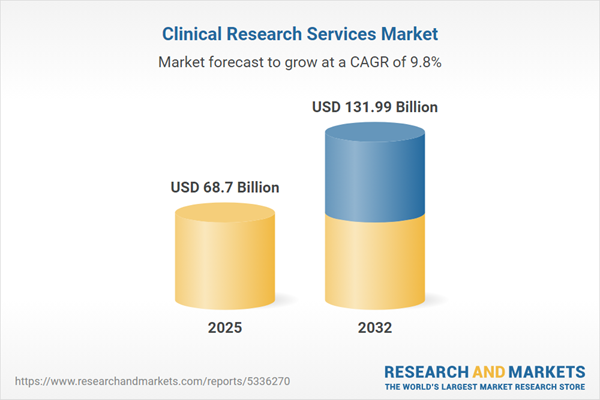Speak directly to the analyst to clarify any post sales queries you may have.
Senior executives in clinical research services face continuous shifts in technology, regulation, and cross-sector collaboration. Staying ahead requires strategies rooted in robust market intelligence to support agile responses and informed investment in operational innovation.
Market Snapshot: Clinical Research Services Market Growth and Outlook
The clinical research services market is on a strong upward trajectory in 2024, valued globally at USD 62.69 billion with projections reaching USD 68.70 billion in 2025 and a substantial USD 131.99 billion by 2032. This growth reflects a compound annual increase of 9.75%. Several drivers fuel this surge: rapid advancements in digital initiatives, increasing complexity of compliance requirements, and the emergence of innovative treatment modalities. Organizations are leveraging advanced data-driven tools and flexible business models to address new regulatory and patient-focused demands. Partnerships across sectors and active technology alliances continue to redefine operational efficiency, ensure compliance, and meet the complex expectations of research stakeholders.
Scope & Segmentation of the Clinical Research Services Market
Comprehensive segmentation within the clinical research services market enables leaders to allocate resources strategically, select agile partners, and plan investments with precision. Understanding these key dimensions enhances data-based decisions and elevates competitive positioning for providers and end users.
- Service Type: Biostatistics, patient recruitment, project management, site and data management, medical writing, and electronic data capture all serve to boost transparency, accuracy, and efficiency at different clinical program milestones.
- Trial Phase: Early-stage development, late-phase trials, and post-marketing surveillance each come with specific compliance needs and innovation priorities, ensuring that each development milestone meets both scientific and regulatory standards.
- Therapeutic Area: Cardiovascular, infectious diseases, neurology, oncology, rare and complex diseases are focal points, addressing both high-growth potential and areas of significant unmet clinical demand across global markets.
- End User: Academic institutions, biotechnology companies, pharmaceutical firms, medical device manufacturers, and contract research organizations each require tailored workflow designs and compliance approaches adapted to their operational models and goals.
- Geographic Regions: North America, Europe, Latin America, Asia-Pacific, Middle East, and Africa each present unique challenges and opportunities, from varying regulatory environments to differing demands for research services, necessitating locally adaptable strategies.
- Technology Adoption: Automated data solutions, remote monitoring, and integrated digital platforms are key drivers of greater transparency, improved compliance, and more personalized engagement throughout the clinical trial process and across diverse markets.
Key Takeaways: Strategic Insights for Senior Decision-Makers
- Implementing agile management systems positions organizations to rapidly respond to changing regulations and enhance trial flexibility.
- Advanced analytics, automation, and artificial intelligence technologies drive progress in protocol optimization and streamline day-to-day clinical operations.
- Integrating decentralized and participant-focused models results in higher engagement levels and more effective data oversight throughout trial lifecycles.
- Strengthening digital supply chains and investing in collaborative technologies can improve compliance, lower supply interruptions, and protect organizational interests.
- Building multidisciplinary teams supports improved data governance, stronger integrity in reporting, and higher project reliability from planning through delivery.
- Strategic alliances with research organizations and technology service providers have the potential to speed up development timelines and safeguard long-term regulatory alignment.
Tariff Impact: Navigating Regulatory and Cost Pressures
The latest U.S. tariff adjustments are contributing to higher procurement costs and increased complexity in managing clinical research supply chains. To counter these challenges, organizations are pivoting toward nearshoring, leveraging automation in sourcing, and establishing robust, flexible supplier networks. These strategies are helping maintain cost controls and minimize risk amid fluctuating market conditions.
Methodology & Data Sources
This analysis is grounded in first-hand interviews with industry executives, critical insights from leading regulatory agencies, and comprehensive reviews of prominent medical journals. The approach aligns with the needs of senior leaders overseeing clinical research service strategies, ensuring all insights remain actionable and directly relevant.
Why This Report Matters
- Empowers executive teams to anticipate technological shifts and regulatory changes, enhancing readiness in clinical research market operations.
- Delivers granular segmentation and up-to-date regional insights, supporting focused investment planning and optimizing partner or procurement strategies.
- Supports leaders in staying ahead of compliance and technology trends, underpinning sustainable business continuity and future-ready service delivery.
Conclusion
Backed by detailed market intelligence, this report equips senior leaders with clear direction to successfully guide their organizations, sharpen strategic focus, and secure notable results in a dynamic industry environment.
Additional Product Information:
- Purchase of this report includes 1 year online access with quarterly updates.
- This report can be updated on request. Please contact our Customer Experience team using the Ask a Question widget on our website.
Table of Contents
3. Executive Summary
4. Market Overview
7. Cumulative Impact of Artificial Intelligence 2025
Companies Mentioned
The companies profiled in this Clinical Research Services market report include:- IQVIA Holdings Inc
- Laboratory Corporation of America Holdings
- Thermo Fisher Scientific Inc
- ICON plc
- Parexel International Corporation
- Syneos Health, Inc
- WuXi AppTec Co., Ltd
- Charles River Laboratories International, Inc
- Eurofins Scientific SE
- Medpace Holdings, Inc
Table Information
| Report Attribute | Details |
|---|---|
| No. of Pages | 186 |
| Published | October 2025 |
| Forecast Period | 2025 - 2032 |
| Estimated Market Value ( USD | $ 68.7 Billion |
| Forecasted Market Value ( USD | $ 131.99 Billion |
| Compound Annual Growth Rate | 9.7% |
| Regions Covered | Global |
| No. of Companies Mentioned | 11 |









